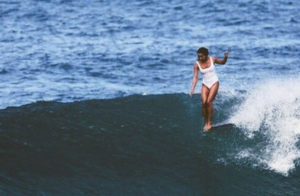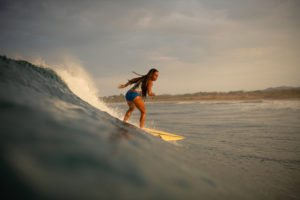how to start surfing
It sounds like such an obvious topic – how to start surfing – but when our team dug into it, it became clear that this deserved some attention. We all have friends who say, “I’d like to try surfing someday” but very few of them get it done. Why is that? Perhaps a lack of true desire or fear of the unknown?
Then, I had a minor epiphany – many potential surfers lack clarity on the basic steps needed to get started.
“Today, we’ll illuminate how to start surfing in very simple steps that will ease you into the sport.”
When we say ‘how to start surfing’ in this context, we literally mean how to enter the starting gate comfortably. We can handle “how to start surfing without looking like a kook,” or “how to start surfing without hurting yourself or your ego” and “surfing better” in other posts.
STEP ONE: Build familiarity with the equipment
Years ago, I taught novices how to snowboard. I took pride in how quickly my students progressed. The key to my technique: Building familiarity with the equipment and setting expectations before ever touching the snow. New surfers can benefit from this approach.
“Showing up to surf camp or lessons with zero knowledge about boards puts you at a disadvantage.”
For your first step, I want you to go online and locate the closest surf shop. Set aside a 1-2 hours to visit (preferably on a weekday). If you’re far from the coast, make a plan to visit a surf shop on your next trip or make a pilgrimage – who cares wins, right?
Browse the board section to get a feel for the different styles, sizes, and shapes. Run your hands down the smooth rail line of a longboard. Feel the slender nose and recall images of a surfer elegantly riding waves with her toes dangling off the edge of the board. Does it seem more or less possible to you now that you’re feeling a board in real life?

Then, pick up a high performance shortboard. Hold it in your dominant arm with the rail in your armpit. Feel the potential speed in its curves and maneuverability in its thinned out tail. Hold it close to your chest and imagine it as your sole possession in the vast ocean. Does it feel comfortable? Look at the posters on the walls – consider the athletes doing huge slashes and airs on boards similar to the one in your hand.

Do the same with a fish, then a fun board. Take your time. Shops rarely pressure you to buy a board. If you do get any flack, please send us a note about it.
“The objective is to use visualization and feel to reduce the gap between your imagination’s perception of surfing and real surfing.”

Think about which type of board speaks to you. No right answers here, it’s all about feel.
“On a perfect chest high day, which board can you visualize yourself riding?”
Now, you’ve set your intention – to be able to ride that sexy board on a nice swell. It’s time to embrace the path to your goal.
STEP TWO: accept the path
Chat with the staff in the shop. Tell them about your intention to one day master a board like the one that felt great in your arms. They’ll enthusiastically share insights as learners and instructors. Remain open-minded as they direct you to explore foamies and beginner boards that look clunky compared to your board of choice. Trust their advice as, that extra foam will be your friend for paddling ease and stability.
“Resist the urge to go too small too early.”
Your path will be similar to Daniel son’s learning from Mr. Miyagi – eating humble pie before graduating to the cool stuff.
I recommend frequenting your surf shop many times. Make friends with the staff. This will pay huge dividends down the road when you’re ordering customs or getting ding repairs.
STEP Three: to buy or not to buy
It’s really up to you. For some, renting boards in the beginning makes sense. Many shops will let you rent a board and wetsuit. I opted to purchase early because it signaled a conscious commitment.
My first board was a used 7’6” Al Merrick M13. It had plenty of volume, stability, and paddling power for my needs. I preferred not to go with a typical longboard because my ambition was to graduate to a shortboard quickly. Plus, the guys at Cinnamon Rainbows Surf Shop in Hampton felt I could manage the M13 as a beginner.
“One advantage buying has over renting is not needing to learn a new board’s tendencies each time you surf.”
Whichever you decide, keep in mind that it’s commonplace to trade in boards.

If you spend a few hundred dollars on a used beginner board, you can usually apply value from it when you step up (or down) to your next stick.
“Whatever you do, don’t buy a surfboard at Costco. Just don’t”
STEP four: build your exposure
Paddle out on a board of any type in flat water – you don’t need to stand up. You’ll notice the board that looked huge in the shop magically feels a lot smaller in the water.
At home, watch instructional videos on YouTube and read board reviews. My favorite reviewer is Noel Salas at Surf’n Show. Pay close attention to the boards being ridden in videos. Doing so with the context of having felt the equipment will help.
“Though cool to see, watching pros throw massive 360s will be less useful than instructional videos for beginners and intermediates.”
Pay close attention to paddling and fundamentals like body position and where to look. I also recommend throwing push-ups, pulling, and shoulders routines into your daily exercise.
STEP five: take action and start surfing
Now that you have some familiarity, you’re ready to go for your first session – be it a surf, lesson or camp. Set a reminder to check surf conditions at the surf spot closest to you. I use Surfline and Swellinfo. Get into a groove of checking 2-3 times per day.
“When the waves look good, pack up the car and go. Plain and simple.”

If you’re fortunate enough to have a partner join you, great. But I recommend being motivated to go solo.
If driving to a spot is not in the cards, investigate surf camps and check conditions at the destination daily. Get a feel for what time of year works best for novices and book your trip. Again, be prepared to go it alone.
“Too often, trying to coordinate schedules gets in the way of learning to surf. Anyway, you’ll meet plenty of new friends there.”
When you finally do have that first lesson, the familiarity you’ve built by being thoughtful in your preparation will build confidence and accelerate your learning.
So, let’s review. To start surfing 1) locate a surf shop, 2) check out the boards, 3) rent or buy, 4) familiarize, 5) check conditions and go! Sounds pretty simple, eh? It is. What are you waiting for? Your future in the ocean awaits!
